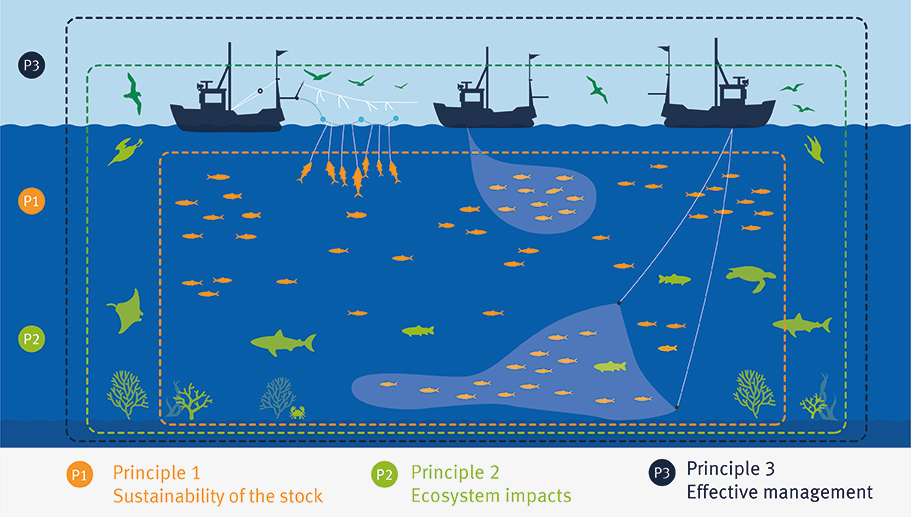Yesterday I received a question about sustainable bottom trawling that I& #39;d like to attempt to answer today. I& #39;ll tag the colleague who asked it at the end so as not to swamp his feed.
Can bottom trawling be sustainable? Sure. Here& #39;s how.
Can bottom trawling be sustainable? Sure. Here& #39;s how.
First, an obligatory brief note, while I work for the MSC, I am not a public spokesperson for them and this response is in my capacity as a scientist familiar with their Fisheries Standard. I did not write the standard and am not involved in ongoing revisions.
I& #39;ll also note that MSC is hardly alone in stating that it is possible for bottom trawling to be sustainable, a cursory search of the SeafoodWatch database reveals 100+ bottom trawl fisheries recommended as "best choice" or "good alternative."
So what is bottom trawling? Bottom trawling consists of dragging a net, often with a heavy chain in front of it, across the seafloor. Here& #39;s what this looks like https://www.youtube.com/watch?v=BcJFSl_YJHk">https://www.youtube.com/watch...
In the wrong place, this type of fishing can obviously be quite destructive. This issue is often discussed in terms of sensitive bottom types, especially coral, seagrass, and sponges.
There are places in the ocean we should not trawl.
There are places in the ocean we should not trawl.
Another concern that has been raised about bottom trawls is their relatively low selectivity. This type of gear can result in bycatch/unwanted catch/non-target catch.
This used to be a big problem with sea turtles, Turtle Excluder Devices have largely solved in many places.
This used to be a big problem with sea turtles, Turtle Excluder Devices have largely solved in many places.
There are other modifications to the gear (mesh size, chain modification, etc) that can significantly reduce their unwanted catch, especially for particular species of concern. This has been studied extensively for things like skates. That& #39;s one way to minimize the impact.
Limiting where or when trawling can take place helps significantly reduce the major concerns outlined above. MPAs do this but so do time-area closures specific to that specific fishery/gear type.
Many habitat types (and their surrounding biodiversity) seem to be able to withstand this type of gear with no significant long term damage, however. https://conbio.onlinelibrary.wiley.com/doi/abs/10.1046/j.1523-1739.1998.0120061230.x">https://conbio.onlinelibrary.wiley.com/doi/abs/1...
In some places, the impacts of bottom trawling on habitat and biodiversity are functionally the same as naturally occurring disturbance to the seabed. There are places we should not bottom trawl. There are places where it seems fine.
http://www.int-res.com/abstracts/meps/v541/p31-43/">https://www.int-res.com/abstracts...
http://www.int-res.com/abstracts/meps/v541/p31-43/">https://www.int-res.com/abstracts...
Given recent misinformation, it& #39;s perhaps worth a brief review of how a fishery gains MSC certification as a sustainable fishery. https://www.msc.org/en-us/standards-and-certification/fisheries-standard">https://www.msc.org/en-us/sta...
The MSC fisheries standard includes 28 indicators, grouped into primary stock sustainability, ecosystem impacts (including habitat impacts and bycatch), and management. People have wrongly claimed that MSC does not factor in bycatch at all. That& #39;s just not correct.
If a fishery fails any of these indicators, the fishery does not get certified.
(Incidentally, why do so few fisheries fail to get certified? Because certification is expensive and time consuming, and if you& #39;re not likely to pass you& #39;re not likely to attempt it).
(Incidentally, why do so few fisheries fail to get certified? Because certification is expensive and time consuming, and if you& #39;re not likely to pass you& #39;re not likely to attempt it).
Generally speaking, to get MSC certified as sustainable, a bottom trawl fishery would need to affirmatively demonstrate that it was not causing serious or irreversible harm on sensitive habitat.
Generally speaking, to get MSC certified as sustainable, a bottom trawl fishery would need to affirmatively demonstrate that it was not having a significant negative impact on endangered species.
Generally speaking, to get MSC certified as sustainable, a bottom trawl fishery would need to affirmatively demonstrate that it was not having a population level effect on non-target species.
There would also need to be a detailed management plan in place, approved by a variety of local stakeholders. And there would need to be lots of data (observers, logbook data, electronic monitoring, etc) confirming the level of impact.
Let& #39;s walk thorugh briefly an MSC-certified trawl fishery, I just chose a Spanish cod fishery because it popped up first when I searched for "bottom trawl"
Incidentally, all MSC certified fisheries have a ton of public data, follow along here:
https://fisheries.msc.org/en/fisheries/agarba-spain-barents-sea-cod/@@view">https://fisheries.msc.org/en/fisher...
Incidentally, all MSC certified fisheries have a ton of public data, follow along here:
https://fisheries.msc.org/en/fisheries/agarba-spain-barents-sea-cod/@@view">https://fisheries.msc.org/en/fisher...
For bottom trawling, I& #39;d be concerned about indicators 2.3.1-.3, 2.4.1-.3, and 2.5.1-.3 so let& #39;s show the scores here: (page 125 of the 2018 reassessment). They& #39;re all green (above 80/100).
When I dig into 2.5.1 (ecosystem outcome), it says "current ICES ecosystem monitoring indicated that the [fishery] is highly unlikely to disrupt the key elements underlying ecosystem structure and function to a point where there would be a serious or irreversible harm"
Several citations are provided here including local government reports and peer-reviewed literature
https://www.sciencedirect.com/science/article/pii/S0079661117300642?via%3Dihub
https://www.sciencedirect.com/science/a... href=" https://academic.oup.com/icesjms/article/72/2/595/672811
https://academic.oup.com/icesjms/a... href=" https://www.ices.dk/sites/pub/Publication%20Reports/Expert%20Group%20Report/IEASG/2018/WGIBAR/WGIBAR%202018.pdf?ID=34411">https://www.ices.dk/sites/pub...
https://www.sciencedirect.com/science/article/pii/S0079661117300642?via%3Dihub
You can do this with every one of the 28 indicators. All the data is publicly available, all the analyses are cited.
The MSC fisheries standard is a high bar for sustainable fisheries, and there are certainly many bottom trawl fisheries that would not meet it. But there are some that can.
There are places we should not bottom trawl. There are species that cannot tolerate fishing like this, either as the target of a fishery or as non-target bycatch.
But there are some that can.
But there are some that can.
Anyway, that& #39;s a really long answer @DeBrauwerM ! But it was a good question and I hope I& #39;ve addressed it here.
For Maarten or anyone else, I& #39;m happy to answer follow-ups or any serous question asked in good faith.
For Maarten or anyone else, I& #39;m happy to answer follow-ups or any serous question asked in good faith.

 Read on Twitter
Read on Twitter



